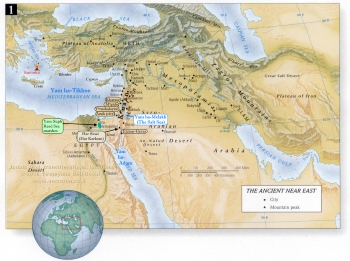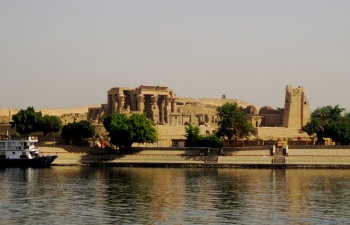
 |
| Egyptian New Kingdom | |
|---|---|
| 14C-Dated Reigns | Pharaohs |
| c BCE | |
| c BCE | |
| c BCE | Ah-kheper ka- |
| c BCE | Ah-kheper en- |
| c BCE | Regent Khât-shepꞋset |
| c BCE | Khât-shepꞋset co-reigns with |
| c BCE | Queen Khât-shepꞋset reigns alone until her death c. B.C.E. |
| c BCE | Men-kheper |
| c BCE | |
| c BCE | Santorini Eruption |
| c BCE | Yᵊtzi•âhꞋ |

After the death of "Generation Yo•seiphꞋ", Bᵊn•eiꞋ-Yi•sᵊrâ•eilꞋ flourished and their population grew.
 Gen Ah-kheper-ka-Ra Djehutymes I Tut-moses I mummy head 0350x436.jpg) |
When Par•ohꞋ Amun-hotep Sr. died![]() leaving no heir, however, the Egyptian Chief of Staff, General
leaving no heir, however, the Egyptian Chief of Staff, General Tut-moses Sr., who was not of the Royal Pharaonic family, stepped into the vacuum as mëlꞋëkh, taking the Pharaonic name Par•ohꞋ Ah-kheper ka-Ra. But this new mëlꞋëkh, who took over the throne of Par•ohꞋ, had risen through the military ranks rather than inheriting the throne within the Royal Pharaonic family. Consequently, he didn't know the story, from an earlier generation, of Yo•seiphꞋ.
 |
Moreover, this new mëlꞋëkh cum Par•ohꞋ came to power with a new agenda: "Look," he announced to his Egyptian populous, "Egypt is overrun with Bᵊn•eiꞋ-Yi•sᵊrâ•eilꞋ! Am Bᵊn•eiꞋ-Yi•sᵊrâ•eilꞋ has multiplied to the point that it outnumbers us. Am Bᵊn•eiꞋ-Yi•sᵊrâ•eilꞋ has become a Fifth Column in Egypt, a "Dark Government." Let us act prudently concerning this Am lest it continue to multiply. Or, whenever we're threatened by an enemy, it might align themselves with fellow Kᵊna•an•imꞋ and other enemies of Egypt and overthrow Egypt from within. Let's get this Am Bᵊn•eiꞋ-Yi•sᵊrâ•eilꞋ out of Egypt!"
 |
| mud-brick home building |
So the Egyptians passed a law authorizing their tax ministers to impose an onerous special tax on Am Bᵊn•eiꞋ-Yi•sᵊrâ•eilꞋ. This special tax forced the Am to work off its tax debts as corvées. So this Am built the cities of depots for Par•ohꞋ — Pi-Tōm (later renamed [Pi-]Ra-moses).![]()
But the more the Egyptians afflicted the Am, the more numerous it became and the more it dispersed throughout Egypt. Then the Egyptians loathed Bᵊn•eiꞋ-Yi•sᵊrâ•eilꞋ, forcing crushing work on Bᵊn•eiꞋ-Yi•sᵊrâ•eilꞋ, making life bitter for this Am with crushing hard work, building with mortar and mud-bricks in the field.
The Egyptian mëlꞋëkh told the Ha•birꞋu women,![]() midwives, "When you attend births of Ha•birꞋu women,
midwives, "When you attend births of Ha•birꞋu women,![]() look for testicles.
look for testicles.![]() If he's a son, put him to death! If she's a girl she may live."
If he's a son, put him to death! If she's a girl she may live."
But the midwives, Shi•phᵊr•âhꞋ and Pu•âhꞋ, revered ha-ël•oh•imꞋ. So they didn't do as mëlꞋëkh Mi•tzᵊraꞋyim had spoken. Rather, they preserved the lives of the boys.
So mëlꞋëkh Mi•tzᵊraꞋyim summoned the midwives, demanding to know, "Why did you do this, preserving the lives of the boys?"
Realizing that the Par•ohꞋ, being a man, wouldn't understand some of the finer aspects of female biology, they answered, "Because the Ha•birꞋu women,![]() aren't like Egyptian women. The Ha•birꞋu women,
aren't like Egyptian women. The Ha•birꞋu women,![]() are khâ•yōtꞋ! Before the midwife can get to them they've already given birth!"
are khâ•yōtꞋ! Before the midwife can get to them they've already given birth!"
So ël•oh•imꞋ enhanced the midwives and the am multiplied and became very powerful. And because the midwives revered ha-ël•oh•imꞋ, the am, while they were building Pi-Tōm, built houses for them too.
|
| ||||
| (The) Nile – Hieroglyph |
Then Par•ohꞋ commanded all of his Egyptian am saying, "Every Ha•birꞋu![]() boy who is born, you shall send down the river-Nile!
boy who is born, you shall send down the river-Nile!![]() But you can let the daughters live."
But you can let the daughters live."
 |
It was at this time that A•mᵊr•âmꞋ,![]() a man of Beit Lei•wiꞋ, wed a Bat-Lei•wiꞋ named Yō•khëꞋvëd,
a man of Beit Lei•wiꞋ, wed a Bat-Lei•wiꞋ named Yō•khëꞋvëd,![]() who then became pregnant and gave birth to a son. She saw that he was a happy baby who was quiet and relatively easy to conceal from the Egyptians. So she concealed him from the Egyptians, keeping him from being sent down the river-Nile,
who then became pregnant and gave birth to a son. She saw that he was a happy baby who was quiet and relatively easy to conceal from the Egyptians. So she concealed him from the Egyptians, keeping him from being sent down the river-Nile,![]() for 3 moons.
for 3 moons.
When she felt she couldn't conceal him any longer, she made a little box out of reeds and water-proofed it with tar and asphalt. She placed the baby boy in the water-proofed reed box and placed him among the reeds near the bank of the river-Nile,![]() where the young daughter
where the young daughter![]() of Par•ohꞋ Ah-kheper ka-
of Par•ohꞋ Ah-kheper ka-Ra Tut-moses Sr., Princess Khât-shepꞋset, came down to bathe in the mornings.![]()
Meanwhile, the infant's sister, MiꞋrᵊyâm,![]() positioned herself some distance away where she could see what would happen to him.
positioned herself some distance away where she could see what would happen to him.
 Khat-shepset keruv sphinx (ancient-egypt co uk Metropolitan Museum) 250x376.jpg) |
When the Pharaonic Princess Khât-shepꞋset came down for her morning bathe on the bank of the river-Nile,![]() as she walked along the bank of the river-Nile
as she walked along the bank of the river-Nile![]() with her attending maids, she spotted the little black, asphalt-sealed reed box floating among the reeds and dispatched one of her maids to fetch it for her.
with her attending maids, she spotted the little black, asphalt-sealed reed box floating among the reeds and dispatched one of her maids to fetch it for her.
When she opened the box and looked inside, there was the crying young boy. The little Princess Khât-shepꞋset felt compassion for the infant, saying, "This is one of the Ha•birꞋu![]() boys."
boys."
 Khat-shepset mummy 250x378.jpg) |
At that point, the baby's big sister, MiꞋrᵊyâm, approached the Egyptian princess who, like her, was also a little girl about 7 years old. Knowing that her little brother was crying because he was hungry for his mother's milk, MiꞋrᵊyâm suggested to Princess Khât-shepꞋset, "Would you like me to go and fetch one of the lactating Ha•birꞋu![]() mothers to breast-feed the baby for you?"
mothers to breast-feed the baby for you?"
The princess agreed. So the little girl, MiꞋrᵊyâm, went and summoned her and her two brothers'![]() mother, Yō•khëꞋvëd,
mother, Yō•khëꞋvëd,![]()
When little MiꞋrᵊyâm returned with her and her brothers' mother, Yō•khëꞋvëd, the little Pharaonic Princess Khât-shepꞋset told her, "Go with this baby boy and breast-feed him for me and I will pay you." So Yō•khëꞋvëd took her son and breast-fed him.
A couple of years later, as soon as she had weaned her son,![]() Yō•khëꞋvëd took him back to Princess Khât-shepꞋset, where the princess adopted him into her Pharaonic Royal Family as her son — a member of the Pharaonic Royal Family in the line of succession (after Ah-kheper ka-
Yō•khëꞋvëd took him back to Princess Khât-shepꞋset, where the princess adopted him into her Pharaonic Royal Family as her son — a member of the Pharaonic Royal Family in the line of succession (after Ah-kheper ka-Ra Tut-moses Jr. and Princess Khât-shepꞋset) to the full royal education and throne of Egypt. Princess Khât-shepꞋset named the boy with the customary four![]() royal Egyptian names in her Egyptian language (which weren't explicitly recorded in Ta•na"khꞋ):
royal Egyptian names in her Egyptian language (which weren't explicitly recorded in Ta•na"khꞋ): HōrꞋus (identifying herself with IꞋsis-moses, having likewise resurrected her own HōrꞋus-moses from a watery grave), plus a personal name (Sen-en-Mut), who then took the Royal Family surname: Tut-moses. However, Bᵊn•eiꞋ-Yi•sᵊrâ•eilꞋ, being forbidden by Tor•âhꞋ to propagate the names of the Egyptian idols, referred to him only as […]-Moses, likening the name to the Hebrew term Mosh•ëhꞋ, because mᵊshi•tiꞋhu.

Optional parental preparation:
Contradictory Datings — Ta•na"khꞋ presents a set of enigmatic, seemingly-unresolvable chronological contradictions. For example, Ta•na"khꞋ in one place (bᵊ-Reish•itꞋ 15.13-14) explicitly specifies that Israel would sojourn as geir•imꞋ in Egypt for 400-years![]() while, in a different passage (bᵊ-Reish•itꞋ 15.16) Israel would be redeemed from Egypt in only the 4th generation, ≈80 years! Faced with these kinds of enigmas, Arts-degreed archeologists have dated the Yᵊtzi•âhꞋ as late as the B.C.E. 13th century, based on unscientific methodologies and often flimsy evidence. Later, scholars pushed the dating a couple of centuries earlier to the B.C.E. 15th century, in conjunction with the Santorini eruption they estimated to mid- B.C.E. 15th century. Holding to the conjunction of the Yᵊtzi•âhꞋ with the Santorini eruption, scientists in 2016 C.E. 14C date the Santorini eruption to c. B.C.E. , pushing the Yᵊtzi•âhꞋ almost another 2 centuries earlier. It's no wonder archeologists have never found evidence from the B.C.E. 13th century of the Yᵊtzi•âhꞋ. There was no Yᵊtzi•âhꞋ in the B.C.E. 13th, or B.C.E. 15th centuries! Start looking c. B.C.E. !
while, in a different passage (bᵊ-Reish•itꞋ 15.16) Israel would be redeemed from Egypt in only the 4th generation, ≈80 years! Faced with these kinds of enigmas, Arts-degreed archeologists have dated the Yᵊtzi•âhꞋ as late as the B.C.E. 13th century, based on unscientific methodologies and often flimsy evidence. Later, scholars pushed the dating a couple of centuries earlier to the B.C.E. 15th century, in conjunction with the Santorini eruption they estimated to mid- B.C.E. 15th century. Holding to the conjunction of the Yᵊtzi•âhꞋ with the Santorini eruption, scientists in 2016 C.E. 14C date the Santorini eruption to c. B.C.E. , pushing the Yᵊtzi•âhꞋ almost another 2 centuries earlier. It's no wonder archeologists have never found evidence from the B.C.E. 13th century of the Yᵊtzi•âhꞋ. There was no Yᵊtzi•âhꞋ in the B.C.E. 13th, or B.C.E. 15th centuries! Start looking c. B.C.E. !
These shifts in chronology of the Ta•na"khꞋ are the result of most everything in the text of Ta•na"khꞋ being chronologically anchored only internally among events described within, with few absolute external anchor dates. Thus, like previous datings, the entire series of Biblical events simply all slide along the historical chronological sequence intact – yet again – another nearly 2 centuries earlier. (See my Chronology Of The Tanakh, From The "Big ðÀèÄéÌÈä" Live-LinkT ![]() .)
.)
This narrows the gap from 4 centuries to about 5 years! Ta•na"khꞋ documents that Mosh•ëhꞋ was 80 years old when he and A•ha•ronꞋ spoke to Par•ohꞋ (Shᵊm•ōtꞋ 7.7). According to latest scholarship, Ah-kheper ka-Ra Tut-moses Sr. began his reign as Par•ohꞋ c. B.C.E. 1701, requiring that Mosh•ëhꞋ was born soon thereafter. If Mosh•ëhꞋ was born, say, the next year, in c. B.C.E. 1700, then he would have been 80 years old c. B.C.E. 1620, only 5 years after the best 14C datings to date of the Santorini eruption – narrowing the previous gaps of 4 centuries to about 5 years. Reduced to this smaller and more manageable gap, errors can be any accumulation of combinations of Pharaonic, archeological and even 14C datings; whether the later Pharaohs were reigning some 5 years earlier or the 14C dating is an understandable 5 years later or some combination. At this point, however, scholars do not know whether the Santorini might be 5 years or more later (or earlier, for that matter), and should be far less sure about the datings of the Egyptian Pharaohs. So the datings I use seem to be about the best scholarly educated guess one can make at this time. It is certainly enough to get readers (and arts-degreed archeologists), for the first time ever, out of the wrong – mythological legends – ballpark and into the right – scientific/scholarly, reality, historical, authentic – ballpark. This, not being absolutely right exactly (which still remains slightly beyond reach), is the goal of not only these Bible stories, but all of the rest of my books, the website (www.netzarim.co.il) and works as well. ![]()
Questions you might anticipate that your child might raise and be prepared to discuss:
What is an heir?
What is a Chief of Staff?
What does flourish mean?
How long ago is B.C.E. ? Why is that the BCE 17th century?
What is the Yᵊtzi•âhꞋ
What was the Pharaonic family?
What does the Latin cum mean? (that became)
What is an agenda?
What is a "Fifth Column"? A "Dark (or Shadow) Government"?
What does prudent mean?
What does align mean?
What does overthrow mean?
What is a tax debt? Tax collectors? What was a corvée?
What does onerous mean?
What is a depot?
What does afflict mean?
What does disperse mean?
What does loath mean?
What is a midwife?
What are testicles?
![]()
 |
 |